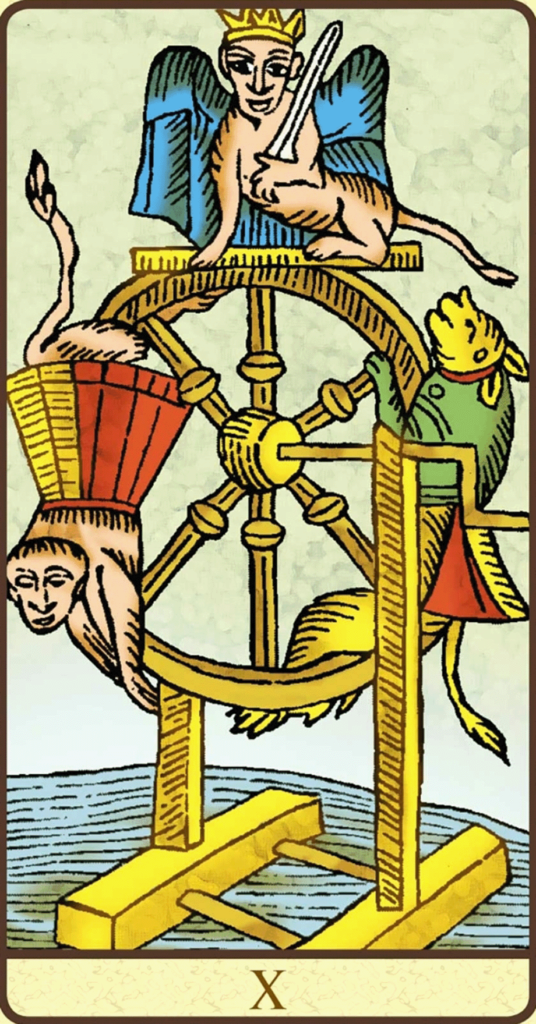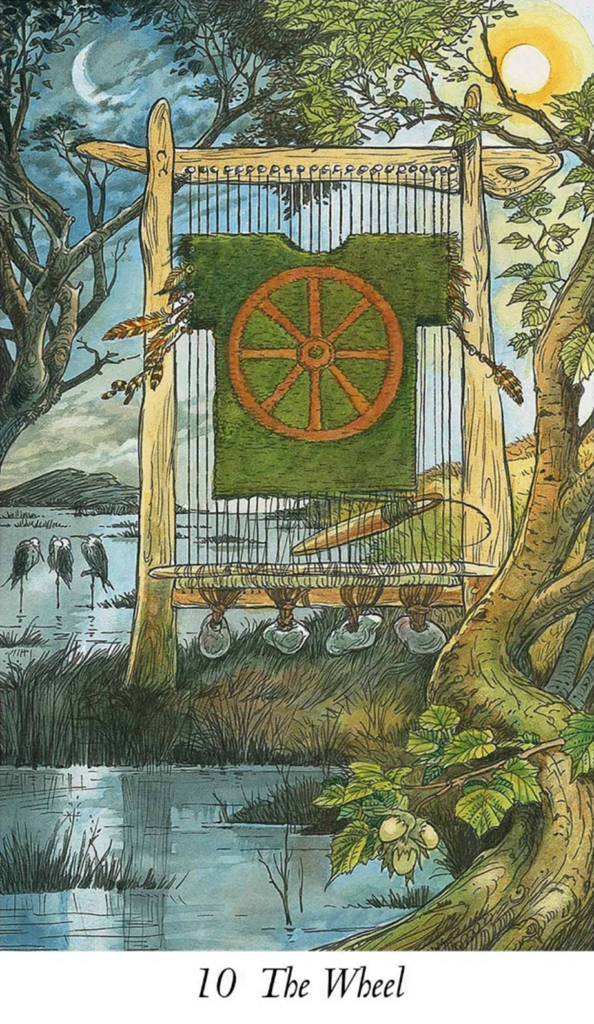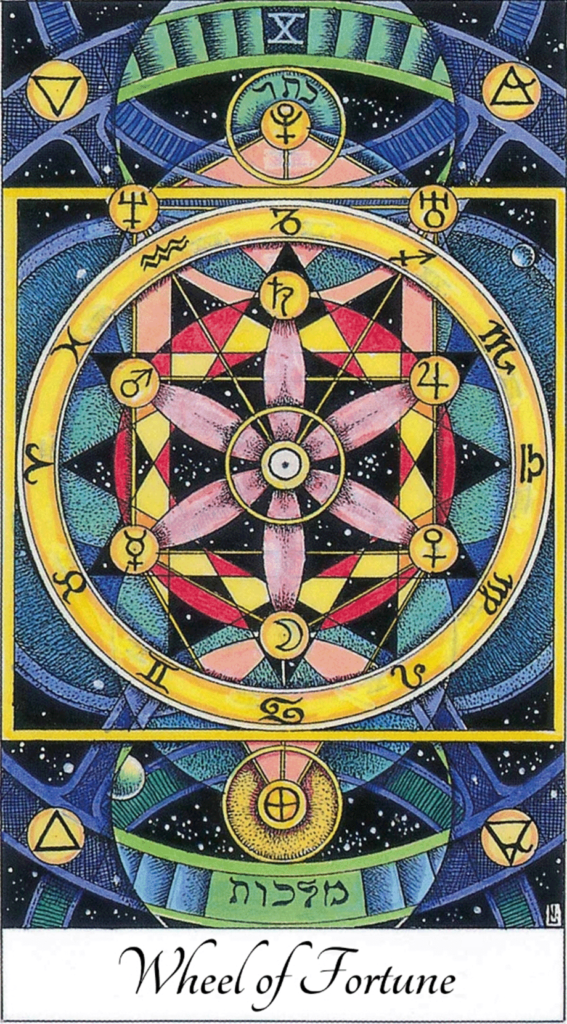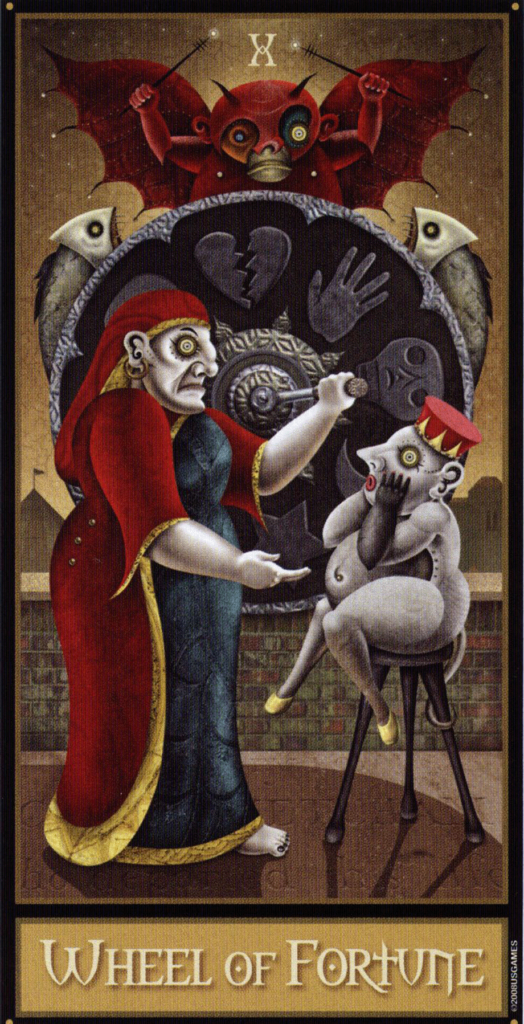What goes up must come down
-Spinning Wheel – David Clayton-Thomas – Blood, Sweat, and Tears
Spinning Wheel got to go ’round
This week we delve into the mysterious symbolism of the card marked X, actually the eleventh card in the Major Arcana. This card is labeled Wheel Of Fortune, and the term both precedes and succeeds it’s use here. Most commonly this card is rendered as luck, or in reverse, the absence of it, yet the history of its symbols give use other avenues to peer down in search of meanings and contexts.

The card shows a triple circle set in the clouds. Within the outer circle are letters in English that may be read in a number of ways, between which four characters in Hebrew. Inside the second circle are eight rays that divide the inner two circles into eight segments. The completely horizontal and completely vertical rays cross over the alchemical symbols for Mercury, Sulfur, Water, and Salt, symbolic of the Aristotelian elements Air, Fire, Water, and Earth. These are not quite the right symbols, but the inference is there. The center circle contains the point where all the rays meet, and is thus the hub of the Wheel. At the Wheel’s top sits a blue female sphinx wearing an Egyptian nemes headress, and holding a sword, by the blade just inside the hilt. On the lower right side of the Wheel is suspended a red figure with what appears to be the head of Anubis. On the left side is the spiral of a yellow snake. On the clouds at each of the four corners are winged figures with books. From the top left clockwise it is a human (or angel) an eagle, a lion, and finally a bull. The sky appearing through the clouds is blue. The Wheel is rendered in orange. T
his is only one of two cards in the entire Tarot deck that has writing as part of the image. The other is the Priestess card, which carries the word TORA on her scroll. If the English letters here are read right to left, as they would be in Hebrew, it also spells TORA. On the other hand, if it is read left to right, as would be normal for English, it reads TARO. This equivalency of Torah, the Hebrew holy book to Tarot the deck of cards is a direct nod to Eliphas Levi’s obsession with the cards as emblematic and revelatory of the teachings of the Kabbalah, and his influence on the Golden Dawn and other magic lodge movements. It is almost certainly where Waite got it.
There’s a kind of triple pun going on here as well, though, because if we begin at the bottom and read clockwise we get ROTA, or “wheel” in Latin. ROTAS, of course, is one of the lines in the well known SATOR AREPO TENET magic amulet, so there’s something of a link to that.
Further permutations give us OTAR, which in archaic Spanish denotes “to see” or “to see from a distance”. By sheer coincidence (if you believe in coincidence) it’s also the anagram for Over The Air Rekeying – a method for updating encryptions codes in modern data cryptography.
The next word around is then AROT, which has connotation in Finnish, Latvian, Sudanese, and a number of other languages. In Finnish it refers to a swamp or marsh (and possibly also has similar meaning in Hebrew). In Latvian, with variations in Spanish and Italian bespeaking of a Latinesque origin, it refers to ploughing. Curiously one of the words in the SATOR AREPO is frequently translated as Plough. One source on the interwebs gives additional Hebrew options that include both vigilance and nakedness. There’s also a Filipino dialect where it means “to speak well”.
If we proceed back the other way from it’s read as TORA, we first come to ORAT, which in the Romance languages seems to harken to “pray”, or “beseech”. Next is RATO, which comes from the Latin for “to judge”, and finally ATOR which can be rendered as “actor” in Latin derived languages, and “poison” in Germanic ones.
While I don’t say with authority that Waite, Smith, or any of there contemporaries played these word games with the letters in the Wheel, they clearly may be played, and are a legitimate method of exploring magically such linguistic symbolism in the various schools and lodges of the time this card was authored.

The Hebrew letters are the Tetragrammaton, made up of Yod, He, Vau, and He, which are pronounced variably Yawveh, or Jehovah. This is the mystic name of the Old Testament God, the Creator of all things in the Hebrew teachings. Jehovah is the Latinization, based probably more on the sound of the spoken Hebrew than any clear connection of the letters between the two. In any case, the implication here is that the apparent randomness of the universe is actually a manifestation of God’s Plan. There is an alternative option, though, in that the Wheel may be viewed as a magic circle, and the inscription here is a protective measure. In this case, the other letters and symbols also function differently.
The alchemical symbols and their elemental attributions seem a bit ham-fisted to me. Firstly, the water symbol at the bottom is really Aquarius, as alchemical notations for water are usually the downward pointing triangle we use when symbolizing those elements directly. Aside from that, the two wavy lines are also a form of the old Egyptian hieroglyph for water, and can have multiple meanings in the contexts of that language. Whereas Mercury and Sulfur are rendered as though they were on the rays, that is, the orientation of the glyph is such that it would appear correctly if one were looking along the ray from the center. Mercury, therefore is rendered upright, but Sulfur has been oriented 90 degrees clockwise. Opposite Sulfur though, the glyph for Salt is rendered upright so that the ray crossing it draws the symbol. Salt is typically rendered as a circle with a line across the center horizontally. This is what is shown here. But to orient it “properly, or in keeping with the way Sulfur is rendered as though it were on a clock’s hand, Salt’s cross line should be vertical, perpendicular to the ray, and thus forming a crossed circle the way this is drawn. The obvious reason not to do this is that a crossed circle is another alchemical symbol, that of Earth. But as Salt here is the stand-in for the element of Earth anyway, the choice seems only confusing, and certainly not in keeping with what would be expected of an initiated magician using these symbols in the creation of a sacred, or at least secret space.

The choice of eight rays and eight divisions, rather than twelve which would give us a number of astrological and temporal associations, seems to be the desire to have them point at the letters on the wheel, which are four in English (or Latin) and four in Hebrew. One can, of course, equate this with the Dharmachakra, or Dharma Wheel that depicts the Eightfold Path. While certainly many in Waite’s circle were influenced by teachings from the subcontinent, I am not sure he had any intention to make the connection here. Crowley’s Book of Thoth borrows more specifically from Eastern teachings, but his Wheel has ten spokes and ten divisions. This version of the Dharma wheel is called “Ten Directions” and is synonymous with “everywhere” or the “universe”. There’s a potential reading of the eight spokes of the RWS Wheel as a kind of compass rose, so that we can ascribe the same meaning. Finally, any chaos magicians out there immediately seized upon the Eight Rayed Symbol Of Chaos from Michael Moorcock’s Eternal Champion series, which has from time to time been adopted to the practice of chaos magic. The significance of the symbol is randomness, and that also fits nicely with the idea of the Wheel of Fortune. We cannot know what is coming.
His Mind is Not For Rent
Tom Sawyer – Peart, Lee, Lifeson – Rush
To any god or government
Always hopeful yet discontent
Knows changes aren’t permanent
But Change is.
The perpetual turning of the Wheel here is the meaning that comes down to us from the earlier versions. The Marseilles deck adorn it with animals (a monkey, an ass or dog, and the sphinx) but in the Sforza and other early decks the figures were men, or kings. There is a version where speech banners are attached to the figures with the mottos “I will rule”; “I rule”; “I have ruled”. The meaning here is quite clear, Time itself is ongoing, and there are no guarantees. Even the king at the bottom, in tatters and rags, may be picked back up by the wheel, and the one at top can easily be thrown down.
The replacement of these figures with ones clearly symbolic is obviously derived from a ritual use associated with the card, or at least deriving from a ritual practice and the symbols used within it. It is no longer about kings or people whom Fortuna has placed highly or displaced, but about the creatures that are attached to the Wheel.
The sphinx here, though undoubtedly supposed to be Egyptian, is more likely to be the one in the tale of Oedipus Rex. According to the story, Oedipus must resolve a riddle posed by this composite creature or be killed. In succeeding, he becomes king and opens up a whole other kettle of fish, but the Sphinx’s riddle is this:
“What is four-legged in the morning, two-legged at noon, and three-legged at end of day?”
The answer is a human, because it first crawls, then walks, and finally leans on a staff-thus three-legged. According to some versions of the story, the riddle game goes on and the Sphinx asks:
“There are two sisters. One gives birth to the second, who in turn gives birth to the first. What are they?”
This is one is equally esoteric, being an allegory of Day and Night, one constantly “giving birth” to the next in an endless cycle.
So here again that Sphinx on the Wheel is a metaphor for the passing of the days. the counting down of our own mortal ones to the point, at the end, when that sword she holds will end them. Yet she holds it not to menace, or even to wield, but only to let us know she has it. Like the threat of being killed, or devoured, or otherwise dealt with facing Oedipus, our Sphinx is telling us that there is no getting off the ride, and there is no one stopping the wheel.

Most writers I have read on the subject suggest this Wheel turns counterclockwise. I am not sure why that would be, but it is the way ROTA reads as well as YHVH so perhaps that is the logic. In this case then Anubis (or whoever that is) represents the rising king. Anubis as a psychopomp is responsible for shepherding the souls of the blessed dead past the perils awaiting them in the underworld, so that they may reach the Chamber of the Weighing of the Heart and be judged as to whether they received eternal happiness or are eaten and face eternal oblivion. In all the versions of the Book of the Dead, the heart always comes through, and one wonders how Anubis ever keeps his pet Devourer fed. But in that context, we can see Anubis as emblematic of a kind of resurrection into the second life of the Field of Reeds, so perhaps that is why he is showing coming up from the bottom of the Wheel, rather than being on the right side completely.
I don’t know if the choice of color here is arbitrary or if Pixie Smith and Mr. Waite simply did not understand the significance of color in Egyptian religion. Red was the color of Set, the murderer of Osiris and god of storms, chaos, and the nearest thing to Satan in the Egyptian pantheon. Anubis is always depicted in black, the color associated with rebirth and the afterlife, probably because of the rich black soil left by the Nile flood. In comparison to the reddish or yellowish sands of the surrounding desert, which was the dominion of Set, this makes a lot of sense. So either they didn’t know, or understand, or they have some double meaning intended.
It’s one of those chicken and egg things. If Set had not killed Osiris, the chain of events that ensued would not have come to be. Anubis himself was born as a consequence of the resurrected but amnesiac Osiris sleeping with Isis twin sister Nephthys (who was the wife of Set, by the way). Isis takes him in and he becomes her protector while her son Horus goes out to do battle with Set to avenge his father. This set of myths informed the mummification and funerary rituals for thousands of years, so they are at the heart of the Egyptian belief in the afterlife. Without the initial evil act of Set, there would not be possible all the good things promised in the Eternal Paradise. While that may have been a bit too esoteric for the ancients (or perhaps not) it may have been in consideration for post Victorians exploring magic and the role of the Christian litany in the face of a Darwinian revolution. Or maybe it’s just me. That’s the beauty of going deep with these cards. You never know which way the rabbit hole turns.
The yellow snake in some rendering is supposed to be two headed. This creature, called an amphisbaena had a head on either end, and thus was capable of going either way at will, like a reptilian pushme-pullyou. The snake as rendered on the card is a normal one, and the looping winding are clearly reminiscent of the Egyptian snake demon Apep or Apophis. This being, often considered an embodiment of Set, attacked the Boat of Ra nightly as it sailed through the underworld, and parts of the Book of the Dead involved the slaying of the beast, and its subsequent dismemberment and burning and the “bones separated by red hot knives”. Apep is both death and nightfall, and in the mind of the Egyptians these were synonymous. If the Wheel turns right to left, then the figure of Apep is descending toward the underworld that Anubis is rising from, and the whole can be seen as a metaphor for spiritual resurrection. This is why I mentioned the symbolism as ritualistic earlier, because ritual death and rebirth is a frequent theme for initiation ceremonies, ranging from the Masonic lodge to the Christian “Born-Again” baptism. It is certainly apt to topics of time passing, fortunes changes, and potential for elevation to a higher plane.

Waite tops off his pseudo-Christian diagrams here with the four symbols in the corners. They are the icons of the four authors of the Gospels, who take the form of the heads of the “living beings” described in the vision of Ezekiel. These creatures, styled in the Middle Ages as Cherubim, an order of non-human angels, were adapted by early embellishers of the Gospel Book to represent Matthew, John, Mark, and Luke. These have been extended by astrologers to represent Aquarius, Scorpio, Leo, and Taurus. These are the fixed signs of Air, Water, Fire, and Earth respectively, signs which are neither initiating the element, nor leaving it, but firmly established within it. As such, they may be taken astrologically as a permanent background against which the Wheel is turning. However, the presence of the book in the hands (or limbs) of each figure is an absolute artistic key that says these are the Gospel authors, and any other allusions we make are secondhand to their presence. One might logically extend our magic circle metaphor to consider these figures as connected with, or representing the four Archangels of the directions typically called during the various consecration rituals. There would seem to be some connection, but I am, as of this writing, unable to find a definitive, one to one attribution of the Archangels to the Gospels and their symbols. They will appear again on the last trump, the World, so hopefully by then my research will have found some authoritative link.
At this point, I have exhausted my current store of information on this symbol rich card, and will close with my thanks for your continued interest, and my hope that you will return in a week to seek Justice, or at least, what that card may offer us by way of imagery and idea.
I look forward to it.

